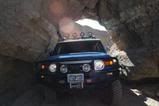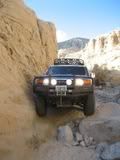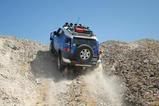gon2srf wrote:Would anyone care to comment on the cons of setting up the camber of an FJ almost an inch beyond Toyota's recommended maximum spec?
http://www.fjcruiserforums.com/forums/s ... -chop.html
Well on my recent trip up to Icon this week The guys there taught me some cool stuff about our suspention I never knew before. There is a HUGE amount of caster adjustment on the FJ that can be used to compensate for the body mount rub, Like almost 4 inches of play!!.(and according to them you want some positive caster anyway for track), So today I bought new tires and while they were being mounted on the rims I tried out the adjustment and sure enough not even close to rubbing, It did throw the toe way out but I was getting an allignment today anyway so it was not an issue, I told the allignment tech to leave as much positive caster as possible while getting the toe and camber in spec. He did and it is awesome, I have well over an inch between my tire and the body mount now when turned. The drawback is it decreases your turning radius but it's so slight it makes no difference.
OH BTW for refrence I'm running 33x12.5 r17 Mickey thompson Baja claws
EDIT###
caster Toyota specs min2.3 max 3.3
Mine 4.1 left
4.2 right
Camber specs -0.4 to 0.6
mine 0.5 left
0.5 right
toe specs 0.00 to 0.05
mine 0.00
__________________
I'll be happy to comment.
Factory wheel alignment specs are designed, after much R&D, to maximize turning radius, minimize rolling resistance, increase vehicle stability at speed and while cornering, and to keep the tire as properly positioned as possible through out the suspensions entire travel range. The 3 major angles that can usually be adjusted are caster, camber, and toe-in. Caster affects the steering axis inclination -if you draw a line from upper spindle mount to lower spindle mount, it would be the relative angle of the front axle forward or rearward of that line (steering axis inclination). Rotate the axle more forward (negative caster), and the vehicle is less stable at speeds, but easier to parallel park (power steering allowed engineers to use more positive caster for stability while the power helped turn the wheel when parking). Relative caster affects the way a vehicle tracks - the vehicle will pull to the side of more negative caster. Mfgrs use this to adjust a car to track straight on crowned roads. Caster does not affect tire wear - only handling and stability. Camber is the angle inward or outward relative to the tire up/down axis. Negative caster causes the wheels to slant inward at the top, better for long travel stability, awful for tire wear. Positive caster can cause a "driving on ice skates" type of feel, and also can cause excess tire wear. Toe-in is the position of the vertical plane of the tire - whether pigeon toed (negative) or duck -footed (positive). Toe in can help with stability, creating a minimal resistance to allow for better control. Too much toe-in, or toe-out, and you'll shred your tires quickly. All of these adjustments are interrelated dynamically, and change throughout suspension travel - hence the range provided by factory specs.
So, back to the original suggestion. While I don't think you have 4" of adjustment that is usable, setting the caster more positive (using lower control arm adjustments) will keep the tire further away from the rear body mount - and cause more stress to the steering system at slower off-road speeds. Seeing how expensive the power steering system components are relative to the ease of a body mount chop, I'd avoid extreme caster changes...

Hope you're still awake....

 _
_ _
_